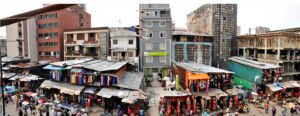The Central Bank of Nigeria announced that the country would not be meeting its 2020 financial inclusion targets. Nevertheless, developments in biometric ID, regulatory sandbox, industry partnerships and agent network growth are on the horizon to put the country back on track.
One of the most interesting discoveries from both the 2014 and 2017 Global Findex reports is the finding that those countries that develop financial inclusion strategies and set measurable, numeric targets are the same ones that show the greatest gains.
 In 2010, Nigeria set an ambitious target to reach 80 percent financial inclusion by 2020 and then launched a National FinancialInclusion Strategy (NFIS) in 2012. So I was disappointed to see that Nigeria experienced a decline in financial inclusion since the last Findex report. In addition, last week, the Central Bank of Nigeria (CBN) released the “Exposure Draft of the National Financial Inclusion Strategy Refresh,” providing some insight into this disappointing performance and confirming that the country was not on track to meet the 80 percent financial inclusion target.
In 2010, Nigeria set an ambitious target to reach 80 percent financial inclusion by 2020 and then launched a National FinancialInclusion Strategy (NFIS) in 2012. So I was disappointed to see that Nigeria experienced a decline in financial inclusion since the last Findex report. In addition, last week, the Central Bank of Nigeria (CBN) released the “Exposure Draft of the National Financial Inclusion Strategy Refresh,” providing some insight into this disappointing performance and confirming that the country was not on track to meet the 80 percent financial inclusion target.
Women’s World Banking has very strong, historic ties to Nigeria and is deeply invested in the success of its financial inclusion strategy. We didn’t want to lose sight of the CBN’s impressive candor and transparency, first, in setting the targets and then in acknowledging the shortfall. We also knew that, through our partnership with Diamond Bank, we launched the BETA Savings Account in 2013 that was tailored specifically to address many of the same barriers to inclusion that were highlighted in the CBN’s report (e.g., reducing KYC hurdles, expanding digital financial services beyond the “lowest hanging fruit.”)
 I reached out to Diamond Bank CEO Uzoma Dozie to get his perspective on the CBN report. He urged us not to shortchange the considerable progress and pointed to several new developments on the horizon that are poised to have a significant positive impact. Uzoma reminded us that Nigeria has collected the biometric data of 32 million people or a “remarkable” 30 percent of bankable adults. With the continuous commitment from the Nigerian Interbank Settlement System (NIBSS) he believes the creation of unique financial identity can be scaled, and at a faster rate. The CBN and NIBSS have also just established a regulatory sandbox to accelerate the development of financial technology solutions to inclusion.
I reached out to Diamond Bank CEO Uzoma Dozie to get his perspective on the CBN report. He urged us not to shortchange the considerable progress and pointed to several new developments on the horizon that are poised to have a significant positive impact. Uzoma reminded us that Nigeria has collected the biometric data of 32 million people or a “remarkable” 30 percent of bankable adults. With the continuous commitment from the Nigerian Interbank Settlement System (NIBSS) he believes the creation of unique financial identity can be scaled, and at a faster rate. The CBN and NIBSS have also just established a regulatory sandbox to accelerate the development of financial technology solutions to inclusion.
Uzoma also called attention to several partnerships between banks and telcos, noting that Nigerians can open accounts wherever they are with a mobile phone that is fully interoperable — still a rarity throughout much of the emerging markets. This provides them with “immediate access to a broader range of digital financial services, just as easily as they can with mobile money but with a much richer bouquet of meaningful lifestyle services.”
The vast majority of Nigeria’s financially excluded population lives in rural areas. In 2016, the North West and North East geo-political zones had financial exclusion rates of 70 and 62 percent, respectively. The upcoming launch of new, shared agent networks will put 500,000 banking agents into the field within two years, making financial services more accessible in rural areas.
It’s hard to resist Uzoma’s optimism about the future for Nigeria’s financial inclusion efforts. We look forward to continuing our work with Diamond Bank and expanding other bank and mobile partnerships in Nigeria to support the country’s financial inclusion efforts. The “refreshed” financial inclusion strategy is an important positive step in getting the country back on track to achieve its targets.


